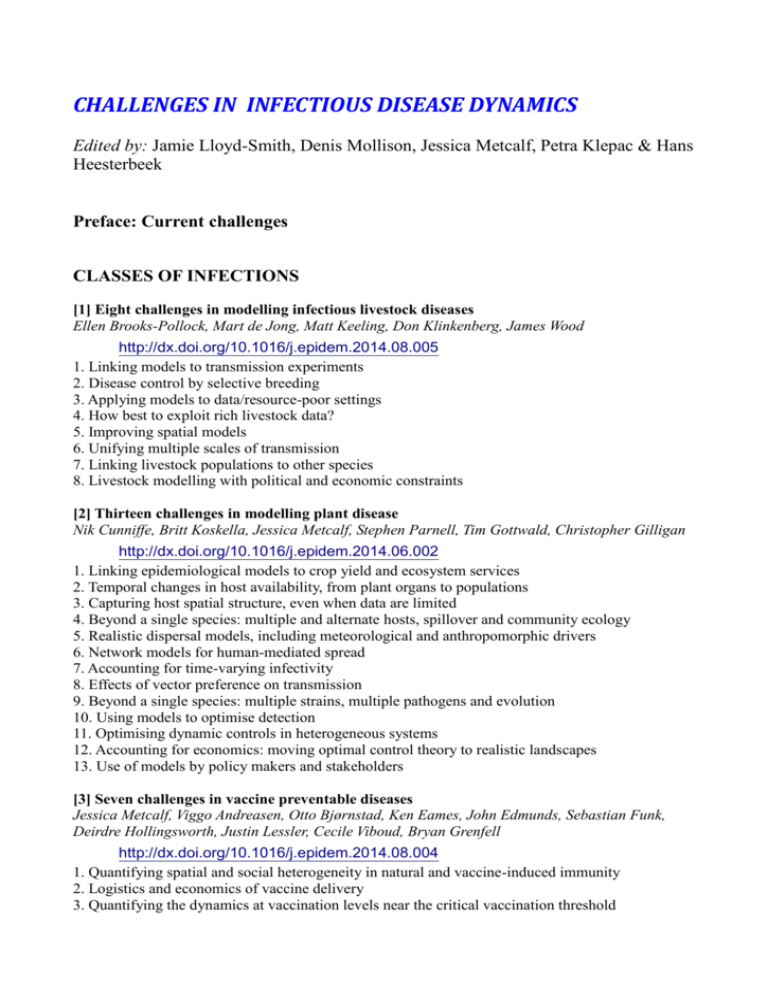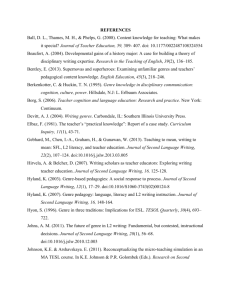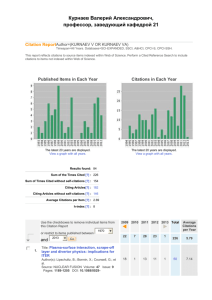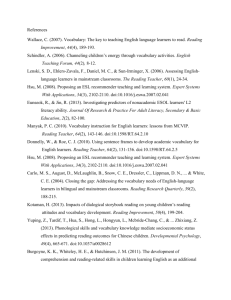Sebastian Funk, Shweta Bansal, Chris Bauch, Ken Eames, John
advertisement

CHALLENGES IN INFECTIOUS DISEASE DYNAMICS Edited by: Jamie Lloyd-Smith, Denis Mollison, Jessica Metcalf, Petra Klepac & Hans Heesterbeek Preface: Current challenges CLASSES OF INFECTIONS [1] Eight challenges in modelling infectious livestock diseases Ellen Brooks-Pollock, Mart de Jong, Matt Keeling, Don Klinkenberg, James Wood http://dx.doi.org/10.1016/j.epidem.2014.08.005 1. Linking models to transmission experiments 2. Disease control by selective breeding 3. Applying models to data/resource-poor settings 4. How best to exploit rich livestock data? 5. Improving spatial models 6. Unifying multiple scales of transmission 7. Linking livestock populations to other species 8. Livestock modelling with political and economic constraints [2] Thirteen challenges in modelling plant disease Nik Cunniffe, Britt Koskella, Jessica Metcalf, Stephen Parnell, Tim Gottwald, Christopher Gilligan http://dx.doi.org/10.1016/j.epidem.2014.06.002 1. Linking epidemiological models to crop yield and ecosystem services 2. Temporal changes in host availability, from plant organs to populations 3. Capturing host spatial structure, even when data are limited 4. Beyond a single species: multiple and alternate hosts, spillover and community ecology 5. Realistic dispersal models, including meteorological and anthropomorphic drivers 6. Network models for human-mediated spread 7. Accounting for time-varying infectivity 8. Effects of vector preference on transmission 9. Beyond a single species: multiple strains, multiple pathogens and evolution 10. Using models to optimise detection 11. Optimising dynamic controls in heterogeneous systems 12. Accounting for economics: moving optimal control theory to realistic landscapes 13. Use of models by policy makers and stakeholders [3] Seven challenges in vaccine preventable diseases Jessica Metcalf, Viggo Andreasen, Otto Bjørnstad, Ken Eames, John Edmunds, Sebastian Funk, Deirdre Hollingsworth, Justin Lessler, Cecile Viboud, Bryan Grenfell http://dx.doi.org/10.1016/j.epidem.2014.08.004 1. Quantifying spatial and social heterogeneity in natural and vaccine-induced immunity 2. Logistics and economics of vaccine delivery 3. Quantifying the dynamics at vaccination levels near the critical vaccination threshold 4. Model immunodynamics – when are protective vaccines possible, and how can we measure protection? 5. Investigate when vaccines are evolution proof and when they are not 6. Determine the implications of radically new vaccine technologies 7. Account for the microbial community ecology of vaccination [4] Seven challenges for modelling indirect transmission: vector-borne diseases, macroparasites and neglected tropical diseases Deirdre Hollingsworth, Juliet Pulliam, Sebastian Funk, James Truscott, Valerie Isham, Alun Lloyd http://dx.doi.org/10.1016/j.epidem.2014.08.007 1. How can complex macroparasite processes best be modelled? 2. Quantifying contributions of host and vector species for vector-borne infections with complex reservoirs 3. Understanding how contact patterns affect the dynamics of macroparasites 4. Measuring vectors to estimate incidence and infection risk in humans 5. Develop robust models for interpreting indirect measures of macroparasitic infection 6. Estimating burden for NTDs 7. Evolution-proof control of vectors UNDERSTANDING DYNAMICS [5] Nine challenges in incorporating the dynamics of behaviour in infectious diseases models Sebastian Funk, Shweta Bansal, Chris Bauch, Ken Eames, John Edmunds, Alison Galvani, Petra Klepac http://dx.doi.org/10.1016/j.epidem.2014.09.005 1. Set the baseline and determine the effect of departing from it 2. Assess how and to what extent behaviour should be modelled explicitly 3. Determine the minimal level of detail required to model differences in behaviour 4. Quantify changes in reporting behaviour 5. Predict the response to interventions and health campaigns 6. Identify the role of movement and travel 7. Develop models that can be verified against data from digital sources 8. Inform real-time data collection 9. Engage in dialogue across disciplines [6] Eight challenges in modelling disease ecology in multi-host, multi-agent systems Michael Buhnerkempe, Mick Roberts, Andrew Dobson, Hans Heesterbeek, Peter Hudson, James Lloyd-Smith http://dx.doi.org/10.1016/j.epidem.2014.10.001 1. What defines a maintenance population? 2. What defines a maintenance community? 3. What are the mechanisms that underlie the dilution effect, and when do they apply? 4. How to estimate cross-species transmission in field settings? 5. How do complex multi-host life cycles affect maintenance? 6. How do community dynamics of parasites and pathogens within individual hosts scale up to host population processes? 7. How do infectious agents affect food web structure and stability? 8. How to deal with currently unobserved ‘dark matter’ in multi-host, multi-agent systems? [7] Five challenges in modelling interacting strain dynamics Paul Wikramaratna, Adam Kucharski, Sunetra Gupta, Viggo Andreasen, Angela McLean, Julia Gog http://dx.doi.org/10.1016/j.epidem.2014.07.005 1. Translating from single host to population strain models 2. The nature of strain space 3. Host heterogeneity: population structure 4. Host heterogeneity: variation in immune response 5. Accumulation of immunity from multiple strains [8] Nine challenges in modelling the emergence of novel pathogens James Lloyd-Smith, Sebastian Funk, Angela McLean, Steven Riley, James Wood http://dx.doi.org/10.1016/j.epidem.2014.09.002 1. Better capture the disease dynamics in proximal non-human species 2. Expand models for cross-species spillover transmission from general principles to specific, mechanistic frameworks integrating all relevant data types 3. Harness pathogen genetic data across the human-animal interface to map transmission and detect adaptation 4. Improve methods to analyze stochastic dynamics after pathogen introduction, accounting for heterogeneities and imperfect observation 5. Improve data collection and analysis to learn from the frequency of singleton (sporadic) cases 6. Develop theory and case studies for the role of intermediate hosts in pathogen emergence 7. Expand models for emerging infections to account for host immunity 8. Devise approaches to measuring infection fatality rates 9. Design robust and efficient approaches to empirical studies of novel pathogens aimed at risk assessment [9] Five challenges in evolution and infectious diseases Jessica Metcalf, R Birger, Sebastian Funk, RD Kouyos, James Lloyd-Smith, VAA Jansen http://dx.doi.org/10.1016/j.epidem.2014.12.003 1. Defining and measuring fitness for pathogens across scales 2. Developing models to capture the impact of co-infection on the evolutionary process 3. Modelling how pathogen characteristics shape the evolution of host immune diversity 4. Understanding maintenance of pathogen diversity 5. Developing better models for the impact of genetic systems on pathogen evolution [10] Seven challenges in modelling pathogen dynamics within-host and across scales Julia Gog, Lorenzo Pellis, James Wood, Angela McLean, Nimalan Arinaminpathy, James LloydSmith http://dx.doi.org/10.1016/j.epidem.2014.09.009 1. New models and new data to elucidate the processes underlying transmission probabilities and bottlenecks 2. Heterogeneity within a single host 3. Dynamic fitness landscapes 4. Interfacing models with deep-sequencing data 5. When and how to model superinfection 6. When to use more than two scales 7. Approaches to linking processes across scales MODELLING METHODOLOGY [11] Nine challenges for deterministic epidemic models Mick Roberts, Viggo Andreasen, Alun Lloyd, Lorenzo Pellis http://dx.doi.org/10.1016/j.epidem.2014.09.006 1. Understanding the endemic equilibrium 2. Defining the stability of the endemic equilibrium 3. Modelling multi-strain systems 4. Modelling time-varying infectivity 5. Modelling superinfection 6. Constructing realistic spatially-explicit models 7. Exploring the interaction with non-communicable diseases 8. Defining the limits of deterministic models 9. Developing robust deterministic approximations of stochastic models [12] [Five] challenges for stochastic epidemic models involving global transmission Tom Britton, Thomas House, Alun Lloyd, Denis Mollison, Steven Riley, Pieter Trapman http://dx.doi.org/10.1016/j.epidem.2014.05.002 1. Introduction and classification 2. Endemicity: persistence of Infection 3. Near-critical behaviour 4. Epidemics in growing populations 5. Mutation and evolution [13] Eight challenges for network epidemic models Lorenzo Pellis, Frank Ball, Shweta Bansal, Ken Eames, Thomas House, Valerie Isham, Pieter Trapman http://dx.doi.org/10.1016/j.epidem.2014.07.003 1. Understanding the effect of heterogeneity on parameter estimation and epidemic outcome 2. Developing analytical methods to generate and study epidemics on static unweighted complex networks 3. Developing analytical methods to model weighted and dynamic networks and epidemics thereon 4. Incorporating waning immunity in network epidemic models 5. Developing and validating approximation schemes for epidemics on networks 6. Clarifying the impact of network properties on epidemic outcome 7. Strengthening the link between network modelling and epidemiologically relevant data 8. Designing network-based interventions [14] Seven challenges for metapopulation models of epidemics, including households models Frank Ball, Tom Britton, Thomas House, Valerie Isham, Denis Mollison, Lorenzo Pellis, Gianpaolo Scalia Tomba http://dx.doi.org/10.1016/j.epidem.2014.08.001 1. Clarify the usefulness and limitations of systems of weakly coupled large sub-populations in modelling the spread of infections 2. Develop a theory for endemic models with household structure 3. Generalise the framework of households model to more complex social structures 4. Develop metapopulation models to reflect spatial population structure 5. Develop inferential methods for data on the emerging phase of epidemics in structured populations 6. Develop computationally efficient methods for calculating thresholds and early exponential growth rates 7. The individual as a habitat [15] Five challenges for spatial epidemic models Steven Riley, Ken Eames, Valerie Isham, Denis Mollison, Pieter Trapman http://dx.doi.org/10.1016/j.epidem.2014.07.001 1. How can network models best be constructed to reflect spatial population structure? 2. How should we model contact structure in spatially heterogeneous populations? 3. How do we define a threshold parameter for spatial models? 4. How should we analalyse models with long distance interactions? 5. On what scale is intervention most effective? DATA ANALYSIS AND INTEGRATION [16] Six challenges in measuring contact networks for use in modelling Ken Eames, Shweta Bansal, Simon Frost, Steve Riley http://dx.doi.org/10.1016/j.epidem.2014.08.006 1. Defining a contact 2. Bounding networks in space, time, and scope 3. Dealing with missing data 4. Measuring weighted and dynamic networks 5. Exploiting indirect information about networks 6. Personal information and ethical concerns [17] Seven challenges for model-driven data collection in experimental and observational studies Justin Lessler, John Edmunds, Betz Halloran, Deirdre Hollingsworth, Alun Lloyd http://dx.doi.org/10.1016/j.epidem.2014.12.002 1. Ensuring a strong empirical basis for models used to fill gaps in data and knowledge 2. Design studies that account for the dynamic nature of disease systems 3. Identifying critical data collection activities in light of high dimensional parameter spaces and substantial structural uncertainty 4. Collecting data to test and parameterize models that bridge spatial scales 5. Collecting data over time scales commensurate with model predictions 6. Integrating infectious disease dynamics and modeling into the every-day scientific process 7. Making it common practice to identify data that would test model hypotheses [18] Four key challenges in infectious disease modelling using data from multiple sources Daniela De Angelis, Anne Presanis, Paul Birrell, Gianpaolo Scalia Tomba, Thomas House http://dx.doi.org/10.1016/j.epidem.2014.09.004 1. How should evidence be weighted? 2. Handling dependence between datasets 3. Efficient estimation of complex models 4. Model criticism [19] Eight challenges in phylodynamic inference Simon Frost, Oliver Pybus, Julia Gog, Cecile Viboud, Sebastian Bonhoeffer, Trevor Bedford http://dx.doi.org/10.1016/j.epidem.2014.09.001 1. How can we account for sequence sampling patterns? 2. How can more realistic evolutionary models be used to improve phylodynamic inferences? 3. What is the role of stochastic effects in phylodynamics? 4. How does the structure of the host population relate to pathogen genetic variation? 5. How can we incorporate recombination and reassortment? 6. How can we include phenotypic as well as genotypic information? 7. How can we capture pathogen evolution at both within and between-host scales? 8. How can analytical approaches keep up with advances in sequencing? THE INTERFACE WITH POLICY [20] Six challenges in modelling for public health policy Jessica Metcalf, John Edmunds, Justin Lessler http://dx.doi.org/10.1016/j.epidem.2014.08.008 1. Communicating the limits of modelling 2. Maintaining the value of models in the face of long time horizons 3. Usefully deploying modelling in the context of ‘black swans' 4. Integrating modellers and model-building into the policy process 5. Economic analysis and decision support 6. Creating a cycle where results inform decisions and vice versa [21] Six challenges in the eradication of infectious diseases Petra Klepac, Sebastian Funk, Deirdre Hollingsworth, Jessica Metcalf, Katie Hampson http://dx.doi.org/10.1016/j.epidem.2014.12.001 1. Provide a systematic framework for when we should try to eradicate 2. Develop quantitative models of the economics of control versus eradication 3. Identify the most effective approaches to achieve eradication 4. Quantify the landscape of susceptibility 5. Improve monitoring during and after the endgame 6. Identify post-eradication opportunities and threats [22] Modelling challenges in context: lessons from malaria, HIV, and tuberculosis Lauren Childs, Nadia Abuelezam, Christopher Dye, Sunetra Gupta, Megan Murray, Brian Williams, Caroline Buckee http://dx.doi.org/10.1016/j.epidem.2015.02.002 1. Understanding infection dynamics in the host 2. Incorporating pathogen genetic variation 3. Accounting for heterogeneous contact rates and changes in behaviour



